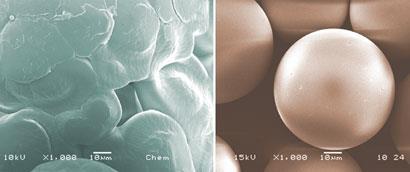Polymer microspheres could deliver stem cells to the eyes of patients to help restore sight destroyed by a common eye disease
Mike Brown/Glasgow, UK
Polymer microspheres could deliver stem cells to the eyes of patients whose sight has been destroyed by age-related macular degeneration (AMD) to repair the damage and enable them to see clearly again, say researchers in the UK.

AMD is one of the leading causes of vision loss in the western world. The disease targets photoreceptor cells in the retina at the back of the eye, leading to loss of central vision. Now, Martin Grossel and coworkers from the University of Southampton have developed biodegradable biopolymer microspheres made from a blend of poly(L-lactide) (PLLA) and poly(DL-lactide-co-glycolide) (PLGA) that could deliver stem cells to damaged photoreceptor cells in the retina and help repair them.
Andrew Treharne, speaking to Chemistry World at Macro 2010 - 43rd Iupac World Polymer Congress in Glasgow, UK, where he was presenting the research, explained that the morphology of the microspheres depends on the ratio of PLLA and PLGA in the polymer blend. ’When the bias is in favour of PLGA you get very smooth surfaced microspheres, but when it favours PLLA, you get much bigger microspheres with rougher surfaces,’ he says.
In vitro tests show model retinal cells adhere better to the larger, rough-surfaced microspheres, and therefore would be better for the delivery of stem cells, Treharne explains.

With funding from the National Institute for Health Research, the team is working with Andrew Lotery, a surgeon and founder of the Gift of Sight charity, to move the research towards clinical applications. They are developing a procedure where a suspension of microspheres decorated with the stem cells arranged in a specific orientation on the surface can be injected under the retina at the damaged site. The microspheres deliver the stem cells to the damaged photoreceptors where they will help repair the cells, before the microspheres biodegrade.
Though the research is still at an early stage, Treharne says the team hopes to move onto animal models after further work on the compatibility of stem cells with the microspheres.
David Chau, a biopolymer and tissue engineer from the University of Nottingham, UK, says the research is ’a step forward’ in the treatment of eye diseases. ’Future challenges would include the possibility of incorporating growth factors, drugs or antibiotics into the microspheres that degrade over time to aid repair and regeneration or prevent inflammation following surgery,’ he adds.
References
HA Thomson et al, J. Biomed. Mater. Res. Part A, 2010, in press






No comments yet